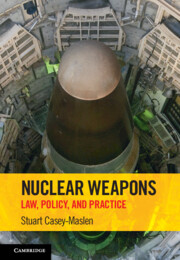Book contents
- Nuclear Weapons
- Nuclear Weapons
- Copyright page
- Contents
- Cases and Materials
- Table of Cases
- Introduction
- 1 The Development of Nuclear Weapons
- 2 Use of Nuclear Weapons
- 3 The Treaty on the Non-proliferation of Nuclear Weapons
- 4 The Testing of Nuclear Weapons
- 5 Agreements between Russia and the United States
- 6 Treaties Prohibiting Nuclear Weapons
- 7 Verification
- 8 Use and Testing of Nuclear Weapons under International Law
- Concluding Remarks on the Future of Nuclear Arms Control and Disarmament
- Select Bibliography
- Index
4 - The Testing of Nuclear Weapons
Published online by Cambridge University Press: 14 October 2021
- Nuclear Weapons
- Nuclear Weapons
- Copyright page
- Contents
- Cases and Materials
- Table of Cases
- Introduction
- 1 The Development of Nuclear Weapons
- 2 Use of Nuclear Weapons
- 3 The Treaty on the Non-proliferation of Nuclear Weapons
- 4 The Testing of Nuclear Weapons
- 5 Agreements between Russia and the United States
- 6 Treaties Prohibiting Nuclear Weapons
- 7 Verification
- 8 Use and Testing of Nuclear Weapons under International Law
- Concluding Remarks on the Future of Nuclear Arms Control and Disarmament
- Select Bibliography
- Index
Summary
Since July 1945, more than 2,000 nuclear explosive devices have been detonated in tests in more than 60 different locations. The total yield of nuclear tests conducted from 1945 to 1995 is equivalent to 34,000 Hiroshima-size bombs. Only North Korea has test-detonated nuclear weapons this century. While the 1963 Partial Test-Ban Treaty remains in force the 1996 Comprehensive Nuclear-Test-Ban Treaty has not entered into force. The chapter explains why and what customary rules restrain nuclear testing today.
- Type
- Chapter
- Information
- Nuclear WeaponsLaw, Policy, and Practice, pp. 98 - 117Publisher: Cambridge University PressPrint publication year: 2021

